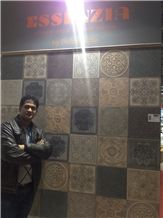flexible thin slate veneer, indian sandstone paving slabs , indian limestone paving slabs, slate ledge stone panels, sandstone pebbles, indian marbles
Stone Name:
Multicolor -
Origin: India
India



flexible thin slate veneer, indian sandstone paving slabs , indian limestone paving slabs, slate ledge stone panels, sandstone pebbles, indian marbles

Cobble stones are the stones that were frequently used in the pavement of streets earlier. Cobble is a generic geological term for any stone having dimensions between 2.5–10 inches.
Cobble stones are typically either set in sand or similar material, or are bound together with mortar. Paving with cobble stones allows a road to be heavily used all year long. It prevents the build-up of ruts often found in dirt roads.
It has the additional advantage of not getting muddy in wet weather or dusty in dry weather. The fact that carriage wheels, horse hooves and even modern automobiles make a lot of noise when rolling over cobblestone paving might be thought a disadvantage, but it has the advantage of warning pedestrians of their approach. In England, the custom was to strew the cobbles outside the house of a sick or dying person with straw to dampen the sound.
Cobble stones set in sand have the environmental advantage of being permeable paving, and of moving rather than cracking with movements in the ground.
cobble stones were largely replaced by quarried granite setts in the nineteenth century. Cobblestone is often wrongly used to describe such treatment. Setts were relatively even and roughly rectangular stones that were laid in regular patterns. They gave a smoother ride for carts than cobbles, although in heavily used sections, such as in yards and the like, the usual practice was to replace the setts by parallel granite slabs set apart by the standard axle length of the time.
Cobblestoned and setted streets gradually gave way to macadam roads, and later to tarmac, and finally to asphalt concrete at the beginning of the 20th century. However, cobblestones are often retained in historic areas, even for streets with modern vehicular traffic. Many older villages and cities in Europe are still paved with cobble stones. In recent decades, cobble stones have become a popular material for paving newly pedestrianised streets in Europe. In this case, the noisy nature of the surface is an advantage as pedestrians can hear approaching vehicles. The visual cues of the cobble stones also clarify that the area is more than just a normal street. The use of cobble stones/setts is also considered to be a more "upmarket" roadway solution, having been described as "unique and artistic" compared to the normal asphalt road environment.
Cobble stones is a perfect choice to be used in gardens, pool surrounds, Pathways, Parking areas, Streets, facads & in many more applications.
We at Bagayat Enterprises are a leading manufacturer & supplier of Cobble stones in various ranges as below:
Sandstone Cobbles:
Kandla Grey, Autumn Brown, Mandana Red, Raj Green, Mint, Modak, Lalitpur Yellow & Buff Sandstone
Limestone Cobbles:
Tandoor Yellow, Kadappa Black & Kota Blue Limestone
Granite Cobbles:
Manga Red/ Pink, Black, Grey, Magadi Red & Yellow Granite